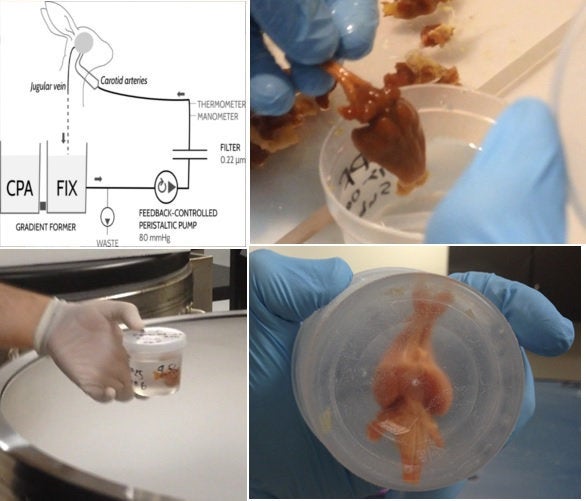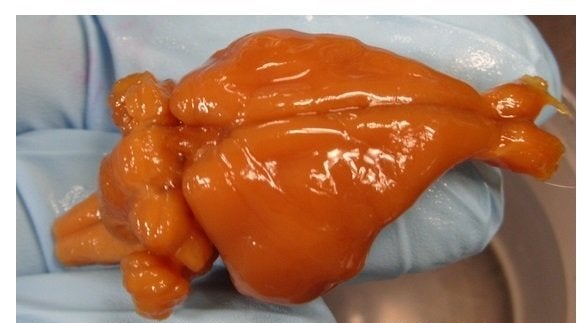For the first time, scientists say the detailed structure of a fully intact mammalian brain has been cryogenically preserved -- but could it pave the way toward the preservation of human brains and memory? It might be too soon to say.
The scientific achievement was announced Tuesday by the Brain Preservation Foundation after a group of researchers successfully froze a rabbit brain as part of a contest and published research about their cryopreservation technique in the December edition of the journal Cryobiology.
While the preserved brain was dead tissue, all of its synaptic connections -- or the junctions of nerve cells -- were maintained, Robert McIntyre, a scientist at company 21st Century Medicine who led the research, told The Huffington Post.
"This research is a first because it works on whole brains and preserves
all of the synaptic details," he said. "Previous techniques, such as resin embedding, are only able to preserve detailed synaptic information in small brain slices."
Indeed, since the 1960s, scientists have been preserving small samples of brain tissue at this level of detail, but they haven't been able to preserve an entire brain until now, according to the BPF.
"The brain was able to be sliced and viewed in an electron microscope which suggested that all the connections had been preserved," Dr. Michael Cerullo, a psychiatrist at the Virginia-based foundation, told Newsweek.

To preserve the rabbit brain, the researchers used a new chemical technique called Aldehyde-stabilized cryopreservation, or ASC, that involved the combination of processes called chemical fixation and cryogenic cooling.
First, the oily liquid glutaraldehyde was used to bind the proteins in the brain together, McIntyre said, and then ethylene glycol -- a powerful antifreeze used in the automotive industry -- was used to protect the brain from the extreme cold.
Next, the researchers cooled the brain to -135 degrees Celsius (or -211 degrees Fahrenheit), causing it to solidify into a glass-like state.
"Ice crystals never form because the ethylene glycol completely inhibits ice crystal formation," McIntyre said. "At -135 degrees Celsius, the brain can be stored for centuries without further decay."
When the organ was rewarmed, slices of it were examined, according to BPF.
"Every neuron and synapse looks beautifully preserved across the entire brain. Simply amazing given that I held in my hand this very same brain when it was vitrified glassy solid," BPF president Dr. Kenneth Hayworth said in a statement. "This is not your father’s cryonics."
McIntyre and his colleague Dr. Gregory Fahy, vice president and chief scientific officer at 21st Century Medicine, were awarded a $26,735 prize from BPF after demonstrating the ASC technique.
The company noted that ASC is not a technique for viable brain preservation, but may be used as a tool by neurobiologists to store rare or valuable brain material for indefinite periods of time.
"This is a technique designed for use by neuroanatomists to better study brain structure," Fahy told The Huffington Post. "This is the first method that perfectly preserves the structure of an entire brain such that, unlike conventional methods, every single part of the brain can be studied in detail to build up a picture of the entire brain."

Some scientists see this research not only as a new way to further study the brain's wiring, but also as a step toward possibly preserving human brains to maintain memory.
"I think that ASC could eventually lead the way to preserving memories in human brains. But using it for a big thing like that requires commensurately big evidence to support it," McIntyre said.
"It's important in general because the level of detail that's preserved with ASC might be sufficient to preserve all of the memories of an individual brain," he added. "This is something that needs to be carefully discussed by the neuroscience community."
Other scientists, however, remain skeptical.
"It's important to think about what condition these organs are in after they've been defrosted for a while," Dr. Hans Bozler, cryogenics expert and physics professor at the University of Southern California, told The Huffington Post. "Having preserved organs appear normal is a far cry from being fully functional."
Still, researchers at 21CM now are working to develop a reversible preservation process.
Additionally, the next stage of the BPF contest will be freezing a large mammal's brain, specifically an intact pig brain -- something 21CM believes it may already have under its belt, but will require review.
Also on HuffPost: